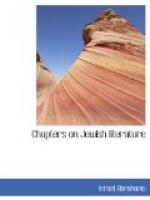At this moment Moses of Leon (born in Leon in about 1250, died in Arevalo in 1305) wrote the most famous Kabbalistic book of the Middle Ages. This was named, in imitation of the Bahir, “Splendor” (Zohar), and its brilliant success matched its title. Not only did this extraordinary book raise the Kabbala to the zenith of its influence, but it gave it a firm and, as it has proved, unassailable basis. Like the Bahir, the Zohar was not offered to the public on its own merits, but was announced as the work of Simon, the son of Yochai, who lived in the second century. The Zohar, it was pretended, had been concealed in a cavern in Galilee for more than a thousand years, and had now been suddenly discovered. The Zohar is, indeed, a work of genius, its spiritual beauty, its fancy, its daring imagery, its depth of devotion, ranking it among the great books of the world. Its literary style, however, is less meritorious; it is difficult and involved. As Chatterton clothed his ideas in a pseudo-archaic English, so Moses of Leon used an Aramaic idiom, which he handled clumsily and not as one to the manner born. It would not be so important to insist on the fact that the Zohar was a literary forgery, that it pretended to an antiquity it did not own, were it not that many Jews and Christians still write as though they believe that the book is as old as it was asserted to be. The defects of the Zohar are in keeping with this imposture. Absurd allegories are read into the Bible; the words of Scripture are counters in a game of distortion and combination; God himself is obscured amid a maze of mystic beings, childishly conceived and childishly named. Philosophically, the Zohar has no originality. Its doctrines of the Transmigration of the Soul, of the Creation as God’s self-revelation in the world, of the Emanation from the divine essence of semi-human, semi-divine powers, were only commonplaces of medieval theology. Its great original idea was that the revealed Word of God, the Torah, was designed for no other purpose than to effect a union between the soul of man and the soul of God.
Reinforced by this curious jumble of excellence and nonsense, the Kabbala became one of the strongest literary bonds between Jews and Christians. It is hardly to be wondered at, for the Zohar contains some ideas which are more Christian than Jewish. Christians, like Pico di Mirandola (1463-1494), under the influence of the Jewish Kabbalist Jochanan Aleman, and Johann Reuchlin (1455-1522), sharer of Pico’s spirit and precursor of the improved study of the Scriptures in Europe, made the Zohar the basis of their defence of Jewish literature against the attempts of various ecclesiastical bodies to crush and destroy it.




